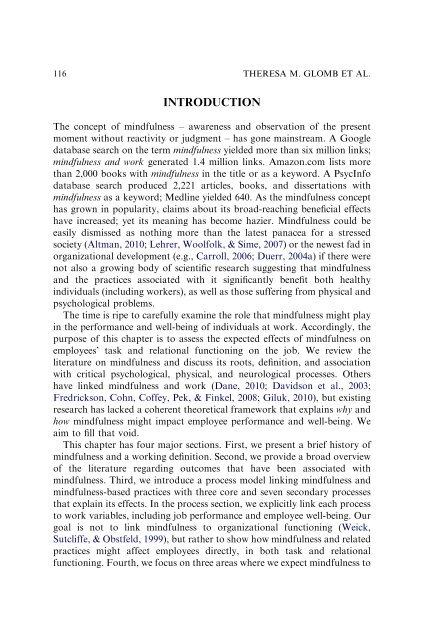Mindfulness at work (Glomb, Duffy et al, 2012) - Human Resources
Mindfulness at work (Glomb, Duffy et al, 2012) - Human Resources
Mindfulness at work (Glomb, Duffy et al, 2012) - Human Resources
Create successful ePaper yourself
Turn your PDF publications into a flip-book with our unique Google optimized e-Paper software.
116THERESA M. GLOMB ET AL.INTRODUCTIONThe concept of mindfulness – awareness and observ<strong>at</strong>ion of the presentmoment without reactivity or judgment – has gone mainstream. A Googled<strong>at</strong>abase search on the term mindfulness yielded more than six million links;mindfulness and <strong>work</strong> gener<strong>at</strong>ed 1.4 million links. Amazon.com lists mor<strong>et</strong>han 2,000 books with mindfulness in the title or as a keyword. A PsycInfod<strong>at</strong>abase search produced 2,221 articles, books, and dissert<strong>at</strong>ions withmindfulness as a keyword; Medline yielded 640. As the mindfulness concepthas grown in popularity, claims about its broad-reaching benefici<strong>al</strong> effectshave increased; y<strong>et</strong> its meaning has become hazier. <strong>Mindfulness</strong> could beeasily dismissed as nothing more than the l<strong>at</strong>est panacea for a stressedsoci<strong>et</strong>y (Altman, 2010; Lehrer, Woolfolk, & Sime, 2007) or the newest fad inorganiz<strong>at</strong>ion<strong>al</strong> development (e.g., Carroll, 2006; Duerr, 2004a) if there werenot <strong>al</strong>so a growing body of scientific research suggesting th<strong>at</strong> mindfulnessand the practices associ<strong>at</strong>ed with it significantly benefit both he<strong>al</strong>thyindividu<strong>al</strong>s (including <strong>work</strong>ers), as well as those suffering from physic<strong>al</strong> andpsychologic<strong>al</strong> problems.The time is ripe to carefully examine the role th<strong>at</strong> mindfulness might playin the performance and well-being of individu<strong>al</strong>s <strong>at</strong> <strong>work</strong>. Accordingly, thepurpose of this chapter is to assess the expected effects of mindfulness onemployees’ task and rel<strong>at</strong>ion<strong>al</strong> functioning on the job. We review theliter<strong>at</strong>ure on mindfulness and discuss its roots, definition, and associ<strong>at</strong>ionwith critic<strong>al</strong> psychologic<strong>al</strong>, physic<strong>al</strong>, and neurologic<strong>al</strong> processes. Othershave linked mindfulness and <strong>work</strong> (Dane, 2010; Davidson <strong>et</strong> <strong>al</strong>., 2003;Fredrickson, Cohn, Coffey, Pek, & Finkel, 2008; Giluk, 2010), but existingresearch has lacked a coherent theor<strong>et</strong>ic<strong>al</strong> frame<strong>work</strong> th<strong>at</strong> explains why andhow mindfulness might impact employee performance and well-being. Weaim to fill th<strong>at</strong> void.This chapter has four major sections. First, we present a brief history ofmindfulness and a <strong>work</strong>ing definition. Second, we provide a broad overviewof the liter<strong>at</strong>ure regarding outcomes th<strong>at</strong> have been associ<strong>at</strong>ed withmindfulness. Third, we introduce a process model linking mindfulness andmindfulness-based practices with three core and seven secondary processesth<strong>at</strong> explain its effects. In the process section, we explicitly link each processto <strong>work</strong> variables, including job performance and employee well-being. Ourgo<strong>al</strong> is not to link mindfulness to organiz<strong>at</strong>ion<strong>al</strong> functioning (Weick,Sutcliffe, & Obstfeld, 1999), but r<strong>at</strong>her to show how mindfulness and rel<strong>at</strong>edpractices might affect employees directly, in both task and rel<strong>at</strong>ion<strong>al</strong>functioning. Fourth, we focus on three areas where we expect mindfulness to


